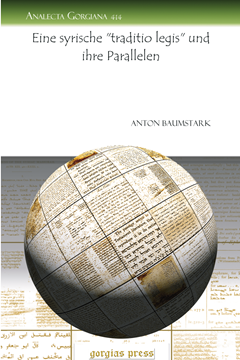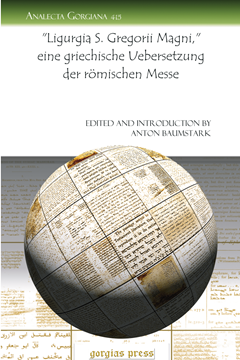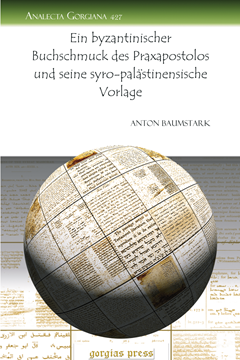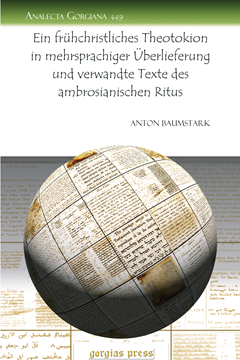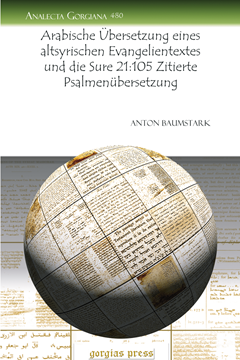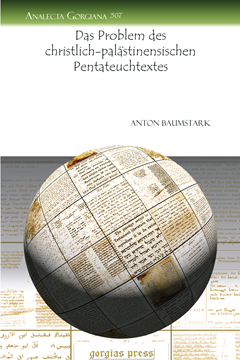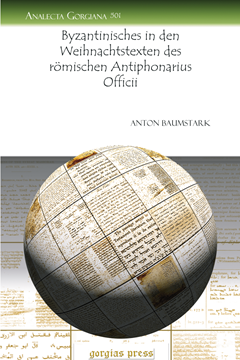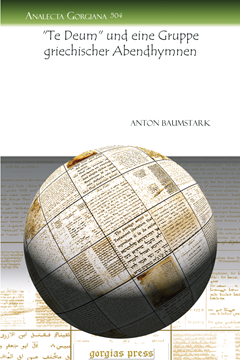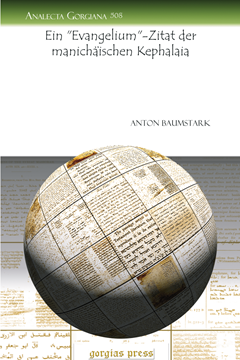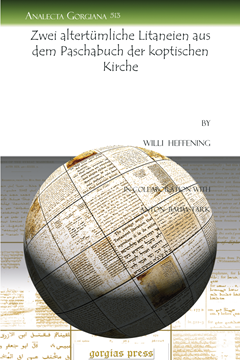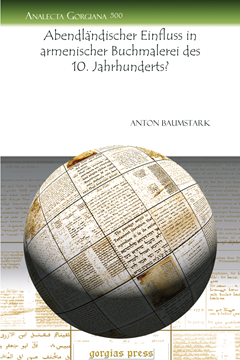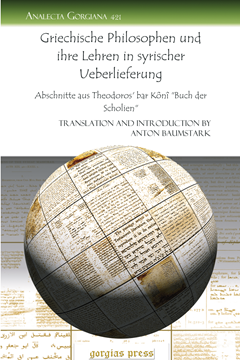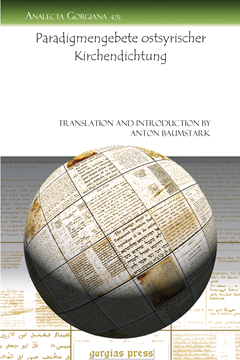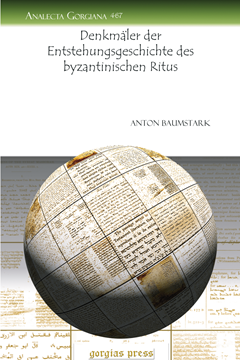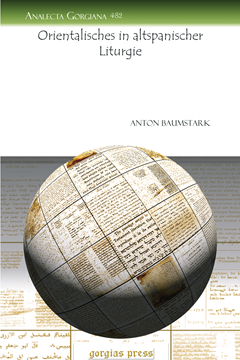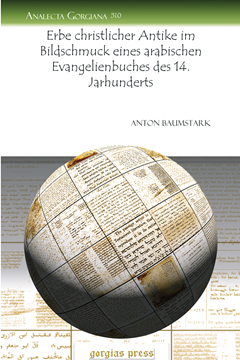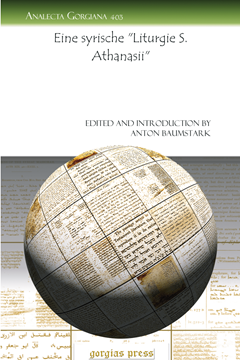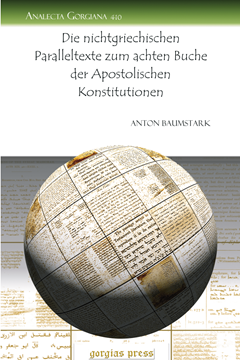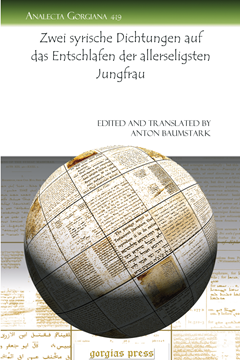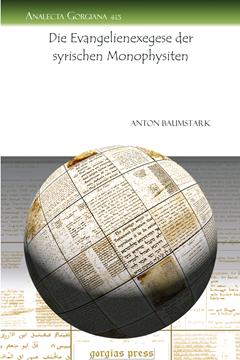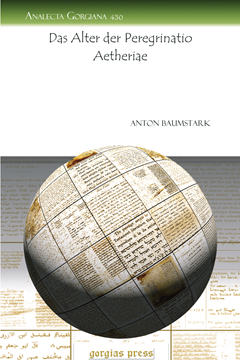Anton Baumstark
Eine syrische "traditio legis" und ihre Parallelen
Series: Analecta Gorgiana 414
ISBN: 978-1-60724-691-6
Early Christian artistic renderings of the traditio legis, exhibit a variety of commonalities and differences. Anton Baumstark compares various versions of the scene and finds evidence of both a Western and an Eastern version represented in multiple sources.
$36.00 (USD) $21.60 (USD)
"Ligurgia S. Gregorii Magni," eine griechische Uebersetzung der römischen Messe
Edited with an Introduction by Anton Baumstark
Series: Analecta Gorgiana 415
ISBN: 978-1-60724-692-3
Anton Baumstark presents the complete Greek text of the Liturgy of Saint Gregory the Great. The liturgy was highly influential in the Latin tradition, but as evidenced by the early translation, it also had limited circulation in the Greek tradition.
$36.00 (USD) $21.60 (USD)
Frühchristlich-syrische Psalterillustration in einer byzantinischen Abkürzung
Series: Analecta Gorgiana 420
ISBN: 978-1-60724-711-1
Anton Baumstark describes thirty Psalter illustrations that he found in a manuscript belonging to the Greek Patriarch of Jerusalem. These illustrations significantly increase our knowledge of Psalter illustrations in the Syriac tradition.
$36.00 (USD) $21.60 (USD)
Ein byzantinischer Buchschmuck des Praxapostolos und seine syro-palästinensische Vorlage
Series: Analecta Gorgiana 427
ISBN: 978-1-60724-733-3
Illustrations were common in manuscripts of the Gospels, but far less common for the Acts and Epistles. Anton Baumstark describes the images found in one manuscript that does include illustrations for these documents and compares them with the Eastern tradition.
$36.00 (USD) $21.60 (USD)
Ein frühchristliches Theotokion in mehrsprachiger Überlieferung und verwandte Texte des ambrosianisc
Series: Analecta Gorgiana 449
ISBN: 978-1-60724-883-5
Anton Baumstark compares the Greek text of a Theotokion preserved in a sixth-century manuscript to comparable texts from the Oriental Christian traditions and the Western Ambrosian Rite.
$36.00 (USD) $21.60 (USD)
105 Zitierte Psalmenübersetzung
Series: Analecta Gorgiana 480
ISBN: 978-1-60724-948-1
The Syriac tradition played an important role in shaping pre- and early Islamic concepts of Christianity. In this article, Anton Baumstark argues that a few Arabic citations of the Bible reflect reliance on Old Syriac translations rather than the Peshitta.
$36.00 (USD) $21.60 (USD)
Das Problem des christlich-palästinensischen Pentateuchtextes
Series: Analecta Gorgiana 507
ISBN: 978-1-60724-986-3
Anton Baumstark discusses the various, complex problems inherent in any attempt to determine the influences from other translation traditions on the form of the Christian-Palestinian text of the Pentateuch.
$36.00 (USD) $21.60 (USD)
Byzantinisches in den Weihnachtstexten des römischen Antiphonarius Officii
Series: Analecta Gorgiana 501
ISBN: 978-1-60724-980-1
In the present essay, Anton Baumstark surveys several Christmas texts from the Roman Antiphonarius Officii in an attempt to find evidence of Byzantine influence. Baumstark focuses the comparison on poetic texts in the Byzantine tradition.
$36.00 (USD) $21.60 (USD)
"Te Deum" und eine Gruppe griechischer Abendhymnen
Series: Analecta Gorgiana 504
ISBN: 978-1-60724-983-2
Anton Baumstark compares selections from the Latin Te Deum hymns with eastern Eucharistic prayers in order to find evidence of eastern influence on the western liturgical tradition.
$36.00 (USD) $21.60 (USD)
Ein "Evangelium"-Zitat der manichäischen Kephalaia
Series: Analecta Gorgiana 508
ISBN: 978-1-60724-987-0
Anton Baumstark compares the text of a Gospel citation found in a Coptic Manichaean Kephalaia with other versions of the text in order to demonstrate that it was influenced by the Diatessaron tradition.
$36.00 (USD) $21.60 (USD)
Zwei altertümliche Litaneien aus dem Paschabuch der koptischen Kirche
By Willi Heffening; In Collaboration With Anton Baumstark
Series: Analecta Gorgiana 513
ISBN: 978-1-60724-992-4
Willi Heffening publishes a German translation of two litanies that are preserved only in a Paschal book from the Coptic Church. Heffening also includes an introduction and supplements the translation with critical notes.
$37.00 (USD) $22.20 (USD)
Abendländischer Einfluss in armenischer Buchmalerei des 10. Jahrhunderts?
Series: Analecta Gorgiana 500
ISBN: 978-1-60724-979-5
In the present essay, Anton Baumstark responds to E. Weigand’s argument for a Western influence on the artwork found in tenth century illustrated Armenian manuscripts by demonstrating that the artistic influences could have come from the Eastern tradition as well.
$37.00 (USD) $22.20 (USD)
Griechische Philosophen und ihre Lehren in syrischer Ueberlieferung
Abschnitte aus Theodoros' bar Kônî "Buch der Scholien"
Translation and Introduction by Anton Baumstark
Series: Analecta Gorgiana 421
ISBN: 978-1-60724-712-8
Anton Baumstark publishes here the portion of Theodore bar Koni’s Scholia that deals with the various Greek philosophical schools of thought. Baumstark provides an introduction to the Syriac text and includes a Latin translation.
$37.00 (USD) $22.20 (USD)
Abû-l-Barakats "griechisches" Verzeichnis der 70 Jünger
Edited with an Introduction by Anton Baumstark
Series: Analecta Gorgiana 406
ISBN: 978-1-60724-681-7
Abu-al-Barakat published two versions of the list of seventy disciples sent out by Jesus. Anton Baumstark presents here the Arabic text, along with a critical Latin version, of Barakat’s list that was allegedly translated from a Greek original.
$37.00 (USD) $22.20 (USD)
Abû-l-Barakats nichtgriechisches Verzeichnis der 70 Jünger
Edited with an Introduction by Anton Baumstark
Series: Analecta Gorgiana 405
ISBN: 978-1-60724-680-0
Abu-al-Barakat published two versions of the list of seventy disciples sent out by Jesus. Anton Baumstark presents here the Arabic text, along with a Latin translation, of Barakat’s list that was allegedly translated a non-Greek source.
$38.00 (USD) $22.80 (USD)
Paradigmengebete ostsyrischer Kirchendichtung
Translation and Introduction by Anton Baumstark
Series: Analecta Gorgiana 451
ISBN: 978-1-60724-885-9
Anton Baumstark surveys the possible literary sources for liturtgical hymn prayers of the Eastern Syriac tradition and also provides a Latin translation of nineteen such prayers found in Bedjan’s Chaldean Breviary.
$38.00 (USD) $22.80 (USD)
Denkmäler der Entstehungsgeschichte des byzantinischen Ritus
Series: Analecta Gorgiana 467
ISBN: 978-1-60724-922-1
Anton Baumstark surveys key developments in the Byzantine liturgical rite and attempts to view these developments within the historical circumstances that likely affected or caused them.
$38.00 (USD) $22.80 (USD)
Orientalisches in altspanischer Liturgie
Series: Analecta Gorgiana 482
ISBN: 978-1-60724-950-4
Anton Baumstark compares elements of the “old-Spanish” or Mozarabic liturgy with eastern liturgies in order to demonstrate an “oriental” influence.
$39.00 (USD) $23.40 (USD)
Erbe christlicher Antike im Bildschmuck eines arabischen Evangelienbuches des 14. Jarhunderts
Series: Analecta Gorgiana 510
ISBN: 978-1-60724-989-4
In the present article, Anton Baumstark describes the decorative illustrations found in an Arabic gospel text of the fourteenth century and concludes that they represent antique artistic features that were preserved only in the Oriental manuscript tradition.
$39.00 (USD) $23.40 (USD)
Eine syrische "Liturgie S. Athanasii"
Edited with an Introduction by Anton Baumstark
Series: Analecta Gorgiana 403
ISBN: 978-1-60724-677-0
This Syriac version of the “Liturgy of St. Athanasius” provides a valuable resource for the development of liturgical materials and practices in the Syrian Monophysite tradition. The text includes a critical apparatus and a Latin translation.
$39.00 (USD) $23.40 (USD)
Die nichtgriechischen Paralleltexte zum achten Buche der Apostolischen Konstitutionen
Series: Analecta Gorgiana 410
ISBN: 978-1-60724-687-9
Book VIII of the Apostolic Constitutions has one of the most complex transmission histories of any text from the Christian Orient. Anton Baumstark describes various sources for parallel texts in order to explicate its translation history in the Oriental languages.
$39.00 (USD) $23.40 (USD)
Zwei syrische Dichtungen auf das Entschlafen der allerseligsten Jungfrau
Edited and Translated by Anton Baumstark
Series: Analecta Gorgiana 419
ISBN: 978-1-60724-710-4
Anton Baumstark publishes two memre on the subject of Mary’s passing. The first is attributed to Jacob of Serug and the second to John of Birta. Baumstark also provides a brief introduction to the texts.
$40.00 (USD) $24.00 (USD)
Eine aegyptische Mess- und Taufliturgie verrmutlich des 6 Jahrhunderts
Edited with an Introduction by Anton Baumstark
Series: Analecta Gorgiana 400
ISBN: 978-1-60724-674-9
Anton Baumstark presents the Arabic text and Latin translation of an Egyptian version of the Testamentum Domini Nostri Jesu Christi. Baumstark discusses the date of the text and compares the content of the liturgical prayers with various contemporary sources.
$40.00 (USD) $24.00 (USD)
Die Evangelienexegese der syrischen Monophysiten
Series: Analecta Gorgiana 413
ISBN: 978-1-60724-690-9
Anton Baumstark presents a historical survey of the development of the exegetical methods of the Syriac Orthodox (“Jacobite/Monophysite”) tradition. Baumstark conducts this survey by detailing the influence of various exegetical works through three distinct historical periods.
$41.00 (USD) $24.60 (USD)
Das Alter der Peregrinatio Aetheriae
Series: Analecta Gorgiana 430
ISBN: 978-1-60724-736-4
Anton Baumstark discusses the critical issues in the dating of the text of the Peregrinatio of Egeria. After comparing the account with other texts, Baumstark concludes in favor of the traditional fourth-century date and provides needed support for this conclusion.
$41.00 (USD) $24.60 (USD)
- 1
- 2

